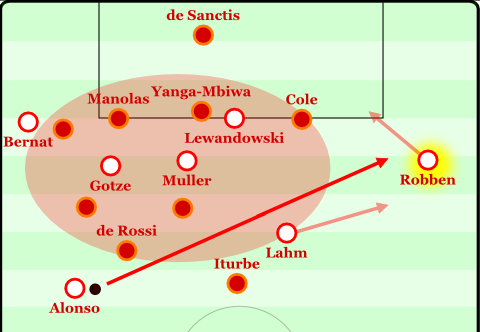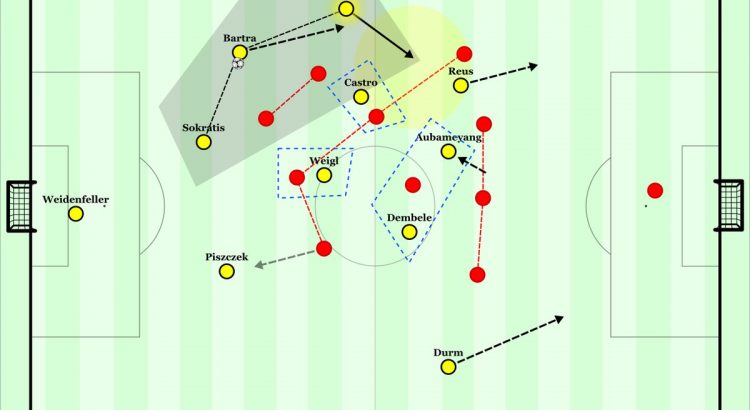What was the impact on Barcelona if the opposition were pressing them high during their 15-pass preparation?
The opponent risks being combined through as Barcelona use the goalkeeper – meaning a natural 11 vs. 10 advantage as you press them. Even if they aren’t near their own goal they are still very talented in tight spaces, so pressing high and leaving space in behind your defense is risky vs. such players who can break presses. Of course they might not be able to position themselves perfectly to begin the positional attack but if they can break the high press then they can progress into the attack in a very advantageous situation. If you are able to press them successfully then you can win the ball high up the field and quickly attack their disorganized positioning in transition! [READ MORE]
How does a team prepare for counter-pressing while in possession?
As mentioned earlier, they find their respective positions – which are hopefully varied and staggered, allowing them to cover many angles, lines, spaces, etc. when the ball is lost. Teams like Leverkusen who play super super fast football play quite a narrow and central formation focused on combinations. This also has a defensive aspect to it – if they are narrow and looking to combine in tight areas, when they lose the ball there are many players immediately near the ball ready to press in defensive transition. So they always look to attack in their specific way but are positioned in a way in their attack which prepares them for defensive transition.
You comment that there is a general rule in a team’s structuring that no more than 3 players can be stationed on a horizontal line and no more than 2 players on a vertical one. Why are these numbers chosen and what would happen to the team’s dynamics in possession if there were more players on the lines then recommended?
The problems that would arise are the same ones as we previously talked about – too many players on the same lines ruin the dynamics of play, connectivity, etc. The reason there are more players positioned on the horizontal axis of the field in general is to have more stabilized possession and be able to switch the point of attack (between flanks, halfspaces, etc.) easier before moving vertically once again. As the goal is to move vertically and eventually score, if 3 players are on the same vertical line – Alaba, Schweinsteiger, and Lewandowksi for example, then one defender pressing the ball could theoretically block all of those players. Again, defences defend vertically so positioning on the vertical axis must be much more varied while horizontal passes are not under as much pressure and allow the team to switch the angle of attack in a more stable manner. If defenders prioritized blocking the 3 players on the horizontal axis, then the vertical pathways would be exposed more easily. Imagine only being able to switch the ball from Ribery into Robben, with nobody in the centre – it wouldn’t be stable! So the more destination points (players) the ball has along its path to the end point (player on the far-side for example), the more stable the pathway will be – though at times it could be more advantageous to skip a destination point and move directly to the end point as it’s quicker and maybe exposes the defence better.
How would a coach be able to reach through to his players these certain rules?
Training! Training with specific lines on the practice fields and explaining the basic rules to the players and then allowing them to try and do it. Though I’d start even more basic – in smaller games I would probably talk to players first about the basics of finding connections and their positioning in horizontal/vertical/diagonal lines with their teammates, then progress to the more complex aspects.
What technical and tactical qualities are essential for a player to be an ‘interior’?
To put it simply, a needle player! In German, players who are able to play in tight spaces are called “needle players.” Those who can control the ball, dribble, and pass under pressure, make great decisions under pressure – I personally prefer the risk takers, play dynamically (which is an underappreciated athletic ability) under pressure, etc. are the types of players necessary. Players like Iniesta, Modric, and Messi – the ones who were born in a small-sided game. The best dribblers understand how to use their body to dribble and manipulate the opponent. They need to be able to find the weak spots in the opponent shape, manage passing distance and connectivity between them and their teammates well, be efficient in combination play, and more!
One quote from your article is “Guardiola chooses different players in his starting lineups based upon how he interprets their movements and their synergies between other teammates on the field”. Could you give a relative example of Pep doing this for either Barcelona or Bayern, and help to explain how the players’ movements benefited each other in contrast to if a different type of player was chosen?
A perfect example would be in the Roma game. In a more specific example from the game, Lahm looked to balance all of Robben’s movements. First of all, the strategy was to expose Roma’s horizontal compactness – so the wing play of Lahm and Robben is an excellent choice in that regard. Later when Roma was more open through the centre then Lahm could offer more to the central combinations. This choice fits well because Robben likes to move from the touchline and cut inside and attack the opponent diagonally. Lahm is both a talented centre midfielder and a talented right back. So when Robben cut inside, Lahm would move out to the flank to balance his movement – which was quite a normal movement for Lahm and he felt comfortable doing it. So Guardiola thought about how each of these two’s natural movements would benefit each other in this specific line up. As for the combination play, Lahm likes to act more as a supportive player in combinations while Robben likes to be within the opponent formation during combinations and penetrate the opponent from within the combination play – so even in this regard he accounted for their characteristics as players and how it would be beneficial to his team for his specific strategy on that match day. This example only includes 2 players because I wanted to keep it simple, but Pep does this for his entire team when creating a system (like the combinations of Lewandowski, Gotze, and Muller through the centre later in the game) – it’s all about the connections!

Pep, himself, says that he truly believes only 3 teams execute the philosophy of PP correctly. Where do teams normally fail in their way of playing it? Can you give any contemporary examples of current teams or ones in the last 10 years?
I personally believe that there are more than just 3 teams who use the PP philosophy correctly, but he’s basically saying that most teams use only a few aspects of PP without really following the philosophy of play completely. A perfect example is the Spanish National Team of 2010 – they were full of Guardiola’s players, but if you ever want to watch a great example of ineffective/non-penetrative possession, you should watch that team! They wouldn’t be considered a true PP team.
Do you think truly successful PP can only be exercised at the very top level, or can teams from lower down the league structures (semi-professional, amateur) perform it? As mentioned by Cruyff, playing in tight spaces, and therefore the technical skills of passing, creating space and receiving under pressure are very intense, therefore wouldn’t these players at this level struggle to adapt to it if their coach introduced it?
As I said before, I believe it is possible on any level – though it must fit your players and your strategy as a coach. Even teams in the lower leagues can seek to use their most talented players in the most crucial positions. It requires a good coach and players who are willing to work hard and learn, and of course the play wouldn’t be at the level of Bayern (unless you have 11 hidden gems in the lower leagues), but the team can still be very successful.
One last question: What advice would you give to anyone who enjoys analysing and studying different team’s style of play that wants to improve in this skill?
In order to improve your analysing skills I would recommend doing A LOT of analysis. Not only on paper, but in your head! Just ask yourself why certain things happen and try to answer all of your questions through research. When doing the analysis you can make it increasingly challenging on yourself to create the analysis – like trying to write one out of memory and then seeing where you got things wrong and why, analysing without pausing the videos, etc. Just keep practicing and looking for answers! The most important thing is to think about everything you are learning, even if it’s something widely accepted by the community – for example, do we really need width? Just a sample question. Good luck!
